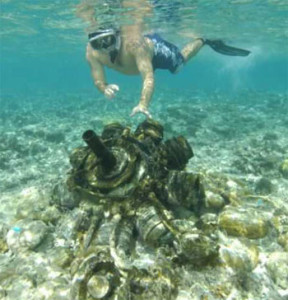If you are lucky, you may have seen a manta or two while diving, but in the waters off the island of Yap, it’s not uncommon to see a dozen or so 12-18ft wide mantas slowly going past you or hovering just above the nearby coral as wrasse and other small fish dart back and forth while cleaning parasites off the mantas.
There are over 100 resident mantas in the waters of Yap, and nightly they go out into the deep waters to feed on plankton, and each morning they return to designated coral cleaning stations to remove microscopic parasitic hitch hikers.
From December to April the mantas display courtship rituals, breach out of the water, somersault and form underwater multiple member conga lines. The word “manta” derives from the Spanish word for blanket, and when a manta gently moves though the waters a few feet above you, the cover is large, wide, and alive. This is just one of the scenarios that plays out daily when you dive Mi’l Channel (Manta Ray Bay or Manta Ridge) or at Goofnuw Channel (Valley of the Rays).
Now, to find Yap on a map, place the tip of your index finger on Hawaii, next place the tip of your middle finger on Guam. Now lift your index finger off Hawaii and rotate it southeast of Guam by about 500 miles and you just found Yap. In reality it is just “plane” easier to take United Airlines on this island hopping adventure.
Although the Indonesians on Yap proper and the Polynesians on the outer islands have been living on Yap for some 3,000 years, it took a European explorer from Portugal in 1525 to discover the Islands. The local Islanders called themselves Wa’ab and with great cultural sensitivity possessed only by Europeans in those days the Islands were promptly called Yap and the people Yapese.
Yap by the way means, “canoe paddle” in Wa’ab.
Yapese are proud of their old cultural ways which include using several sizes of stone money. Some of the stone circular coins are 12ft in diameter and take some 20 men to lift.
When they set these stones in groups it is called a bank.
They may trade the stones during ceremonies, or during transfer of land, but although the ownership of the stones may change, the location of these giant monetary units tends to be set in stone. Yapese typically went to Pulau’s Rock Island where they quarried and shaped the large stones, then they brought them 280 miles back to Yap using nothing more than canoes made out of mahogany or breadfruit trees and with sails made out of plaited leaves. For navigation they used their masterful knowledge of a group of 32 stars passed down from generation to generation.
Bill Acker first came to Yap in 1976 as a Peace Corps volunteer and within a few years began Yap Divers. He and his family now own and operate Manta Ray Bay Resort. Each of the rooms comes complete with modern conveniences and beautifully decorated marine themes from nudibranchs, sharks, fish, squids, or stingrays. Rooms with ocean views, private plunge pools, stone showers, or a private rooftop jacuzzi are very popular.
Yap Divers has eight boats of various sizes to take you to Rainbow Reef where 30-40 mandarin fish perform romance rituals daily. At Vertigo, steep ledges and free handouts ensure sharks of all types such black tips, silky, gray reef, white tip, black tips, will show up. Scalloped hammerheads, nurse, leopard, zebra, and whale sharks are often spotted around some 50 other known dive sites. Yap Caverns is a must do for any diver that loves caves and swim-throughs.
From Hunter’s Bank Seamount, a sunken island, 17 miles North of Yap to 15 miles east at Yap Trench that descends down 28,000ft you have a chance to see coral cabbage patches, torpedoes, machineguns, and other military artifacts, schools of large humphead wrasse, bluefin trevelly, giant trevelly, yellowfin, skipjack, wahoo, mahi-mahi, barracuda, red snapper, and grouper. Dolphins, pilot whales, and even Orcas whales pass by Yap.
So if your client would like to dive a 8,243sq mile manta ray preserve, view some 200 soft and hard coral species, see some military war relics, observe or take images of numerous small to pelagic fish, snorkel with small jellyfish and nudibranchs, do some game fishing, kayak around mangrove lined canals, paddle to secluded beaches, or just do some incredible scuba diving with over 100ft of visibility, then they may wish to spend some time on an island called Yap.
Maduro’s Yap dive package includes savings up to $535, 2nd diver dives free, 7, 10 or 14 night dive packages, travel period bonuses and competitive airfares
Maduro Dive, www.madurodive.com

